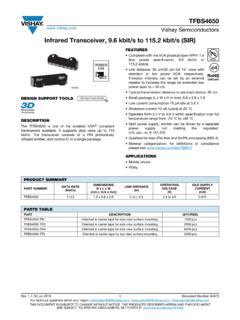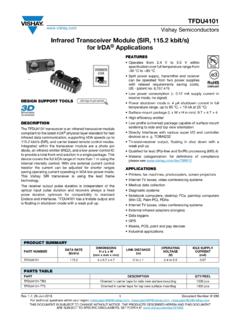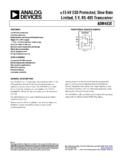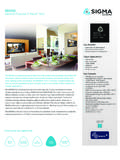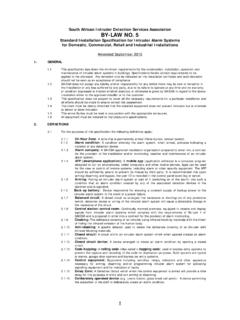Transcription of Interface Products Design Guide Using CAN, LIN …
1 Interface Products Design GuideUsing CAN, LIN and infrared ConnectivityAnalog and Interface product SolutionsLIN TransceiverMCP201 General Purpose I/O ExpanderMCP23016 MicrocontrollersPIC12F675 PIC18F6680 Stand-alone CAN ControllerMCP2515 CAN TransceiverMCP2551 CAN I/O ExpanderMCP250xxDesign ideas in this Guide are based on many of the Interface devices available from Microchip Technology. A complete device list and corresponding data sheets for these Products can be found at Encoder/DecoderMCP2120 IrDA Protocol HandlerMCP2140 MCP215x2 Interface Products Design Guide Interface Products Design Guide 3 product specifications can be found on page 10 Controller Area Network (CAN)MCP2515 Stand-alone CAN Controller Features:n Implements CAN at 1Mb/sn Masks and filters to filter out unwanted messagesn Two receive buffersn Three transmit buffersn High speed SPI Interface (10 MHz)n Low voltage operation ( V V)n One shot mode to ensure a message transmission is only attempted oncen Start-of-frame (SOF) signal pin to detect CAN start-of-frameCAN Design Example.
2 Simple Sensor NodeSimple Sensor Node Using MCP2515 Stand-alone CAN ControllerThe CAN bus (Controller Area Network) protocol was designed to be a high-speed, reliable communication protocol for command and control network applications. Microchip offers a complete line of Products to meet the needs of high-performance embedded applications Using the CAN protocol, including 8- and 16-bit microcontrollers (MCUs) with integrated CAN, stand-alone CAN controllers, CAN I/O expanders, and CAN transceivers. As CAN continues to grow and proliferate into other markets, the need to add CAN to simple sensor circuits increases. In some applications, a simple CAN sensor node can be cost prohibitive due to the higher cost of Using a microcontroller with integrated CAN modules. Often the microcontrollers with integrated CAN have n Data byte filtering of the first two data bytesn Clock out pin with prescaler can be used as a clock sourcen Interrupt output pin with selectable interrupt enablesn Two buffer full pins (can be used as general purpose outputs)n Three request-to-send pins (can be used as general purpose inputs)n 18-pin PDIP and SOIC, 20-pin TSSOP extra peripherals, program memory, RAM, etc.
3 Which the simple sensor application does not addition to MCUs with integrated CAN, Microchip offers a low cost stand-alone CAN controller with SPI Interface (MCP2515) which can be paired up with the desired MCU to create an optimized CAN node. The designer does not have to settle for the peripherals offered by an MCU with integrated CAN, but rather the designer can choose the MCU which best matches the best matches the , the four pins used by the MCU for SPI can be regained by Using the general purpose inputs and out-puts on the schematic shown below represents a very simple, low cost CAN Interface Products Design Guide Interface Products Design Guide 3 product specifications can be found on page 10 Controller Area Network (CAN)CAN Design Example: Adding CAN to Existing ApplicationsExisting applications that require the addition of CAN will find that the MCP2515 can be used to add CAN connectivity to any application ranging from low-end simple sensor applications, to high-end DSP, 32-bit MCU, ASIC, CAN NodeThe MCP2515 can be used to easily add dual CAN capabilities for a given node.
4 The diagram shows CAN added to a high-end application, as many high-end processors do not have embedded CAN Interface Products Design Guide Interface Products Design Guide 5 product specifications can be found on page 10 MCP250xx CAN I/O Expander Features:n Implements CAN Bn Masks and filters to filter out unwanted messagesn Two receive buffersn Three auto transmit buffers for sending messages automaticallyn Non-volatile memory for user configurationn Configuration can be modified via the CAN busn Message scheduling capability Sends GPIO and analog dataController Area Network (CAN)MCP250xx CAN I/O ExpanderThe MCP250xx devices operate as I/O expanders for a CAN system. These devices feature several peripherals including eight digital I/O, four 10-bit A/D converters, and two 10-bit PWM channels. In addition, the MCP250xx can automatically send messages when an input changes state, including when an analog chan-nel exceeds a preset threshold.
5 The device can also be configured to send A/D and digital I/O messages at regular bits (plus the RTR bit or one more ID bit for direction) are reserved in the identifier/arbitration field of CAN Design Example: Simple Sensor Network Using CAN I/O Expanderthe CAN message to communicate with the MCP250xx. This allows a master CAN node to communicate/control the CAN I/O Expanders via the CAN Sensor NetworkThe MCP250xx is ideal for simple, low cost sensor networks. Particularly where the higher layers are proprietary so the system designer can maximize the MCP250xx features. The diagram below shows a four-node sensor network Using only one Eight general purpose I/O pins individually select-able as inputs or outputs Individually selectable transmit-on-change for each inputn Four 10-bit analog channels with programmable conversion clock and Vref sourcesn Individually selectable threshold detectionn Two 10-bit PWM outputsn Low voltage operation ( V V)n 14-pin PDIP and SOIC4 Interface Products Design Guide Interface Products Design Guide 5 MCP2551 CAN transceiver Features:n Implements ISO 11898-2 physical layer requirementsn Suitable for 12 V and 24 V systemsn 40 V short circuit protection on the bus pins Automatic thermal shutdown protectionn 250 V transient protection on the bus pinsController Area Network (CAN) Design Example: Basic Connections Using CAN Transceiverthe bus.
6 The differential signal is less prone to electrical disturbances. The MCP2551 protects the CAN controllerfrom electrical anomalies such as voltage spikes, short circuits, and other electrical transients on the diagram below shows the basic connections for connecting the specifications can be found on page 10n Ground fault (permanent dominant) detection on the transmit input pin Keeps faulty transmitters from bringing down the bus due to a permanent dominant conditionn Externally controlled slope on the bus pins to reduce RFI emissionsn Power on reset and brown out detectionn Unpowered nodes will not disturb the busn Up to 112 nodes can be connectedMCP2551 CAN TransceiverThe MCP2551 is a high speed CAN transceiver which serves as an Interface between the CAN bus and the CAN controller. The MCP2551 implements the ISO 11898-2 physical layer requirements which is by far the most common physical layer for MCP2551 converts between logic levels generated by the CAN controller and differential signal levels on 6 Interface Products Design Guide Interface Products Design Guide 7 Local Interconnect Network (LIN)Example Designs: Typical Applications Using LIN transceiver MCP201 LIN TransceiverLIN is a low speed network (20 kbaud) intended for automotive and industrial applications where the speed and robustness of CAN is not needed and where low cost is essential.
7 The MCP201 is a LIN transceiver which provides the Interface between the LIN bus and the LIN controller. The MCP201 converts between CMOS/TTL levels and LIN diagram shows a typical implementation of a LIN node Using the LIN transceiver Features:n Supports LIN rates up to 20 kbaudn 40 V load dump protectedn Operates from 6 V to 18 Vn Robust LIN bus pin Protected against ground shorts Protected against loss of ground Automatic thermal shutdown High current drive (40 mA to 200 mA) n Built in voltage regulator (LDO) 5 V output ( 5 % tolerance) 50 mA maximum output currentn Internal thermal overload protectionn Internal short circuit protectionTypical MCP201 ApplicationTypical LIN Network Confi guration6 Interface Products Design Guide Interface Products Design Guide 7 product specifications can be found on page 10 infrared CommunicationsExample Designs: infrared Data ApplicationsMCP2150 and MCP2155 IrDA Protocol Protocol Stack Controller The MCP215x devices allow an embedded systems designer to Interface to popular IrDA standard devices (such as PDAs and PCs) Using the embedded systems host controller UART and some I/O pins.
8 The MCP215x implements the IrDA standard stack. At the application layer, the IrCOMM protocol (9-wire cooked service class) is the IrDA standard replace-ment for the serial cable. Thus the embedded systems designer will Interface to the MCP215x as if it was a serial cable. The MCP215x does not implement the IR transceiver of the physical diagram below shows a typical system block Features:n Implements the IrDA standard including: IrLAP IrLMP IAS TinyTP IrCOMM (9-wire cooked service class)n UART to IrDA standard encoder/decoder Interfaces with UARTs and infrared transceiversn UART support to Data Terminal Equipment (DTE) interfaces (MCP2150) or Data Communication Equipment (DCE) interfaces (MCP2155)n Supports s bit width for transmit/receiven Independent UART and IR baud rates n UART baud rates: 906 kbaud kbaud kbaud kbaudn IrDA baud rates: 906 kbaud kbaud kbaud kbaud kbaudn 64 byte data packetn Programmable device IDn Operates as a Slave Devicen Hardware pin for low power modeNote 1: The CD and RI signals have different directions (and functions) between the MCP2150 and the 2.
9 Please refer to MCP2150 Data Sheet (DS21655) or MCP2155 Data Sheet (DS21690) for the function of the HostUART signals (TX, RX, RTS, CTS, DSR, CD, and RI). Not all signals may be required in your application (see AN858)8 Interface Products Design Guide Interface Products Design Guide 9 product specifications can be found on page 10 IrDA Protocol Stack ControllerExample Designs: Using 9600 Baud IrDA Protocol Stack ControllerMCP2140 IrDA Protocol Stack ControllerMCP2140 has all of the same features as the MCP2150 except:n Supports discrete IR circuitry instead of integrated infrared transceivers MCP2120 Features:n UART to IrDA encoder/decodern Supports IrDA physical layer specification ( )n Interfaces with IrDA compliant transceiversMCP2120 infrared Encoder/DecoderUnlike the MCP2150 and MCP2140 which implement the IrDA stack, the MCP2120 is simply an encoder/decoder. This allows the application processor to implement all or part of the IrDA stack, or implement a custom protocol diagram below shows a typical system block Interfaces to standard UARTsn Operates up to the full IrDA data rate ( kbaud) kbaud maximumn Low power modeNote 1: Not all microcontroller I/O pins are required to be connected to the Host UART and IR Interface fixed at 9600 baudn Fixed device IDn Wake-up on IR detectThe diagram below shows a typical system block diagram and typical discreet IR transceiver8 Interface Products Design Guide Interface Products Design Guide 9 product specifications can be found on page 10 MCP23016 Features.
10 N I2C Interface to connect to a microcontrollern 400 kHz maxn Three hardware address pins for up to eight devices on the busn High current drive for each outputn 25 mA maxn Sixteen individually selectable I/O pinsn Interrupt capture register to capture interrupt conditions on the I/On Polarity inversion register to configure the polarity of each inputn Interrupt outputThe MCP23016 provides 16-bit, general purpose parallel I/O expansion for I2C applications. The MCP23016 is an ideal solution when additional I/O are needed for power switches, sensors, push buttons, LEDs, diagram shows a typical use for an MCP23016 GPIO ExpanderGeneral Purpose I/O ExpandersExample Designs: Using General Purpose Parallel I/O ExpandersTypical Application Using the MCP23016 GPIO Expander10 Interface Products Design Guide Interface Products Design Guide 11 Interface ProductsSelected product SpecificationsSee Microchip product Selector Guide for complete product selection and specifications Stand-alone Controller Area Network (CAN) ProductsDeviceOper.










